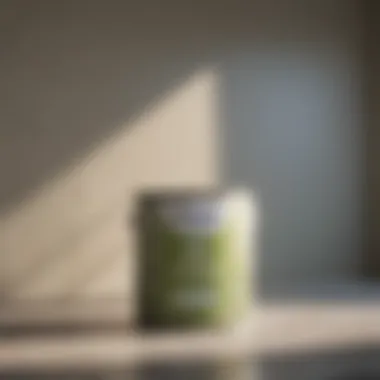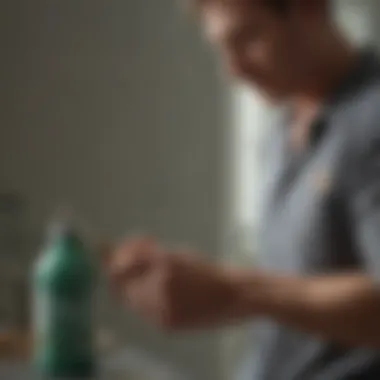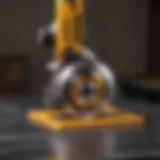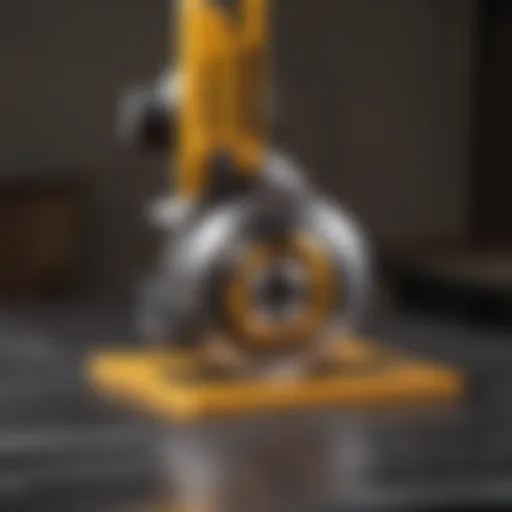A Comprehensive Guide to Valspar Interior Paint


Intro
Valspar interior paint offers a wide array of options for homeowners looking to enhance their living spaces. In the home improvement industry, paint selection goes beyond mere aesthetics. It serves as a foundation for transforming a room's atmosphere, influencing the perceived size and mood. Understanding the properties, finishes, and colors available in Valspar's lineup is crucial. Selecting the right paint can significantly impact the longevity and durability of a wall finish. This guide aims to assist both enthusiasts and professionals in navigating these choices.
Overview of Topic
Valspar, a prominent name in the paint industry, presents a diverse range of interior paint products tailored for different preferences and needs. Their offerings encompass various finishes, including matte, eggshell, satin, and semi-gloss, each with distinct characteristics. Additionally, Valspar's color selection is robust, providing countless options to personalize any space. The eco-friendliness of their products plays a critical role today. Homeowners prioritize low VOC emissions for healthier indoor air quality. Consequently, Valspar has developed options that meet these growing demands.
Understanding this topic is vital for any homeowner contemplating a painting project. Its importance stretches from the idea of sustainability to achieving a desired aesthetic effect. Proper knowledge facilitates a well-informed decision that aligns with both aesthetic desires and practical maintenance considerations.
Common Challenges and Solutions
Homeowners face several challenges when selecting and applying Valspar interior paint.
- Color Selection: The vast selection can be overwhelming. Homeowners may struggle to visualize how a color will appear in their own space.
- Finishing Types: Choosing the right finish for different rooms can be confusing. Each finish serves distinct needs.
- Application Techniques: Improper application can lead to poor results. Homeowners sometimes rush through or overlook crucial steps.
- Solution: It's advisable to use color samples provided by Valspar. Testing a small area can help in making a final decision.
- Solution: Consider the room's function. For high-traffic areas, a durable satin or semi-gloss might be suited, while matte finishes work well in low-traffic spaces.
- Solution: A step-by-step approach is necessary. Proper surface preparation, the right tools, and patience are key to achieving a smooth finish.
"The right paint is not just about color, it's also about how it will stand up to life in your home."
Product Recommendations
When considering Valspar interior paint, several products stand out for their quality and performance:
- Valspar Signature: This paint offers excellent coverage, making it ideal for various surfaces. It features a durable finish resistant to fading and stains.
- Valspar Ultra: Known for its low odor and low VOC formulation, it is suitable for environments where air quality is a concern.
- Valspar Eco: If sustainability is a priority, this line emphasizes eco-friendly components without compromising on color depth or finish.
Each recommended product has unique benefits that cater to different needs, whether it’s durability, ease of application, or ecological considerations.
Step-by-Step Guides
For homeowners looking to apply Valspar paint effectively, here are practical steps:
- Surface Preparation: Clean and repair any imperfections. Ensure the surface is dry and smooth. This step is essential for a professional finish.
- Choose Your Color: Use samples to test colors in different lighting conditions. The same shade can appear differently based on light.
- Select the Right Finish: Decide based on the room’s use and desired effect.
- Application Tools: Gather necessary tools such as brushes, rollers, and painter's tape. Each tool serves its purpose in achieving a smooth finish.
- Apply the Paint: Start with edges and corners using a brush, then use a roller for larger surfaces. Follow up with additional coats as needed after drying completely.
- Clean Up: Properly clean brushes and tools while the paint is still wet. Store any unused paint for future use.
- Enjoy Your Work: Take a moment to appreciate the transformed space. A well-painted room can provide a new sense of relaxation and pride.
By following these steps, homeowners can achieve impressive results using Valspar interior paint, enhancing their environments while gaining confidence in their DIY abilities.
Preamble to Valspar Interior Paint
Valspar interior paint represents an integral consideration for anyone looking to undertake a painting project within their home. This brand, with a rich history and a diverse range of products, has made a significant mark in the paint industry. Understanding Valspar begins with recognizing its commitment to quality and innovation.
The importance of this section lies in outlining the various aspects that Valspar caters to, including durability, ease of application, and a wide selection of colors. Such elements are crucial for house owners and housewives who wish to enhance their living spaces with aesthetic yet functional choices. With Valspar, the benefits extend beyond color; they include performance metrics that are critical for maintaining the home's ambiance with long-lasting results.
In addition, Valspar provides options for eco-conscious consumers, making it easier to choose paints that meet sustainability goals. As the demand for environmentally friendly products rises, Valspar positions itself as a leader with its low-VOC offerings. This makes it ideal for those concerned not just with aesthetics, but also with the health and well-being of their families.
For readers embarking on a painting journey, understanding Valspar's interior paint options can ensure informed decisions that resonate with their vision and practical needs.
"Choosing the right paint can influence both the atmosphere of your home and your overall well-being."
History of Valspar
The history of Valspar is crucial to understanding the brand's position in the interior paint market today. Recognizing its past offers insight into its current product range, innovative practices, and commitment to quality. Valspar has established a strong reputation over many years, becoming a household name among homeowners and DIY enthusiasts alike. Their rich history not only reflects their commitment to excellence but also informs how they continuously adapt to new trends and consumer needs.
Foundational Background


Valspar was founded in 1806 in Minneapolis, Minnesota. Initially, the company specialized in paint for the varnish market, setting the stage for its future in overall paint production. The name Valspar originates from a patented combination of varnish, which indicates their early dedication to creating high-quality finishes. Over the decades, the company emerged as a significant player in the coatings industry, known for innovation and quality. Valspar began to broaden its product offerings, moving beyond varnishes to include paints and finishes suitable for a wider range of applications, particularly in residential settings.
In the late 20th century, Valspar launched various initiatives focusing on sustainability. The introduction of eco-friendly products coincided with a growing consumer awareness of environmental issues. This shift not only positioned Valspar as a forward-thinking brand but also appealed to burgeoning demands for lower environmental impact in home renovations.
Evolution Over Time
Throughout its existence, Valspar has experienced numerous phases of transformation. The company went public in 1962 and made strategic acquisitions, expanding its operational footprint globally. These acquisitions enabled Valspar to diversify its product range and improve its development capabilities. The company invested heavily in research and development, focusing on creating paints that are not only aesthetically pleasing but also durable and easy to apply.
Valspar's commitment to sustainability continued to evolve. In the 21st century, they introduced low-VOC (volatile organic compounds) options, an essential move as regulatory standards became stricter. Such innovations underscored their commitment to providing safer products for consumers and better performing paint for homes.
In 2017, the brand made a significant milestone by being acquired by Sherwin-Williams, one of the largest paint companies in the world. This acquisition not only strengthened Valspar’s market share but also further enhanced its ability to innovate and provide consumers with superior products. Today, Valspar continues to offer a wide variety of interior paints and strives to meet the changing needs of homeowners through ongoing adaptation and innovation in their product line.
Product Range of Valspar Interior Paint
The product range of Valspar interior paint is a critical aspect of this article as it showcases the variety and versatility offered by the brand. Valspar's extensive selection allows consumers to find a product that aligns with their specific needs, ensuring optimal performance and aesthetics. Understanding this range can help buyers make informed decisions that are suited to their living spaces, ultimately enhancing their interior environments.
Types of Interior Paints
Flat Paint
Flat paint is characterized by its non-reflective finish. This type is ideal for ceilings and low-traffic areas where imperfections need masking. Its key characteristic is a smooth matte surface that absorbs light, creating a cozy feel within a room. Flat paint is a popular choice because it tends to be easy to touch up and can hide wall flaws effectively. One disadvantage is its lower washability, which means it may require more frequent repainting in high-traffic areas.
Eggshell Finish
Eggshell finish offers a slight sheen, striking a balance between matte and glossy. This finish is particularly well-suited for living rooms and bedrooms, providing a soft appearance while being wipeable. The main benefit of eggshell is its durability, making it suitable for moderate traffic areas. It can be challenging to apply, as touchups might be noticeable due to the sheen, but its aesthetic appeal often outweighs this drawback.
Satin Finish
Satin finish is recognized for its velvety look, which makes it suitable for higher-traffic areas such as hallways and children’s rooms. Its key characteristic is a soft luster that is easy to clean, providing practicality in daily life. Satin paint is a beneficial choice due to its blend of durability and aesthetic appeal. A possible downside is the increased visibility of surface imperfections, making proper preparation essential before application.
Gloss Finish
Gloss finish stands out for its high sheen, making it excellent for highlighting architectural features like moldings and trims. It is durable and very washable, which is useful in areas prone to spills or stains. The key aspect of gloss finish is its reflective properties, which can enhance lighting in a room. However, this may require meticulous surface preparation, as imperfections are more apparent on glossy surfaces.
Color Selection
Color Palettes
Color palettes are vital in setting the tone of a room. Valspar offers an extensive range of color choices that cater to various styles and preferences. The key characteristic of these palettes is the blend of trendy and classic shades, enabling homeowners to achieve the desired aesthetic. A unique feature of Valspar's color palettes is their coordinated combinations, allowing for harmonized designs. One disadvantage could be decision fatigue due to the overwhelming number of options available.
Trends in Color Choices
Understanding trends in color choices enables homeowners to create modern spaces that feel current. Popular trends include neutral tones, bold accent walls, and the use of earthy colors. The notable aspect of these trends is their ability to transform spaces while also reflecting personal style. However, sticking too closely to trends can lead to a quickly dated design if not paired thoughtfully with timeless elements.
Eco-Friendly Options
Low-VOC Paints
Low-VOC paints are essential for those looking to minimize indoor air pollution. The key characteristic of these paints is their significantly reduced volatile organic compounds, making them safer for both the environment and inhabitants. These paints are beneficial for areas like nurseries or bedrooms. However, their performance can sometimes lag behind traditional paints, requiring careful consideration by the consumer.
Sustainable Practices
Valspar's commitment to sustainable practices demonstrates their efforts towards eco-friendliness. This includes using responsibly sourced materials and energy-efficient manufacturing processes. The key aspect is that these practices not only reduce environmental impact but also appeal to conscious consumers. A potential downside is that eco-friendly options may come at a higher price, which can deter some buyers.
Key Features of Valspar Interior Paint
The section on key features is crucial in understanding the value proposition of Valspar interior paint. These features define how well the product will perform in a home setting and whether it will meet the specific needs of the user. Each characteristic carries implications for usability and overall satisfaction, from initial application to long-term durability. Homeowners and DIY enthusiasts can make well-informed decisions based on an understanding of these features, ultimately optimizing their painting projects.
Durability


Durability is one of the most important features of Valspar interior paint. A durable finish ensures that paint will withstand the rigors of a household environment. Valspar offers a range of products designed to resist chipping, fading, and peeling. This is particularly valuable in high-traffic areas where walls can experience wear over time. The enhanced durability means fewer touch-ups and less frequent repaints, which saves both time and money in the long run.
Moreover, Valspar incorporates technologies that enhance the durability of their paints. For instance, many of their lines feature a formulation that provides resistance against moisture, making it ideal for kitchens and bathrooms. The robustness of Valspar’s paints can help maintain the aesthetic appeal of a space, preserving its visual integrity even in challenging conditions.
Ease of Application
Ease of application is a key attribute that can determine the success of a painting project. Valspar is designed keeping usability in mind. The paints are user-friendly, allowing both professionals and amateurs to achieve satisfactory results. The smooth consistency of Valspar paint enables even coverage, reducing the likelihood of streaks and patches. This aspect is particularly beneficial for first-time painters.
Furthermore, the drying time plays a crucial role. Valspar products often feature quick-drying formulations, which allow for faster completion of projects. The time between coats is minimized, enabling users to finish jobs with a sense of efficiency. For those concerned about air quality, many Valspar paints are low in volatile organic compounds (VOCs), making it safer for indoor use.
Washability
Washability is another significant feature that adds to the practical nature of Valspar interior paint. With life comes spills and stains, particularly in households with children or pets. Valspar paints often offer high washability, allowing homeowners to easily clean walls without damaging the finish. This property is essential for maintaining the cleanliness and appearance of painted surfaces.
The washability factor is especially pronounced in satin and eggshell finishes, which are designed to endure scrubbing. When a surface can withstand the rigors of cleaning, it enhances both the functionality and aesthetic of the home. Knowing that walls can be cleaned easily provides peace of mind for homeowners, allowing them to focus on enjoying their space rather than worrying about maintenance.
"Durability, ease of application, and washability are not merely features; they define your experience with Valspar paint. Investing in these elements ensures satisfaction and longevity in your projects."
Selecting the Right Valspar Interior Paint
Selecting the proper interior paint is crucial for achieving your desired aesthetic and ensuring long-lasting results. Valspar offers a plethora of options, making it essential to consider specific elements before making a decision. Factors such as the room's purpose, existing lighting, and personal style all play significant roles in the selection process.
Inevitably, the choice of paint will impact your home’s atmosphere. Choosing the right Valspar paint can enhance a space, making it feel more inviting, cozy, or even energizing, based on your color selection and finish. A well-chosen paint not only beautifies but also protects surfaces, making it a worthwhile investment for house owners and housewives alike.
Assessing Room Conditions
When selecting Valspar interior paint, start by assessing the conditions of the room where it will be applied. Consider the following factors:
- Lighting: Natural and artificial light greatly influence how colors appear. A room with abundant natural light may allow for more vibrant colors, while a darker room may require lighter shades to enhance brightness.
- Moisture Levels: Rooms like kitchens and bathrooms often experience higher moisture levels. For those spaces, opting for Valspar’s moisture-resistant options may be wise to prevent peeling or mold growth.
- Current Colors: Analyze the existing paint or decor in the room. Will your new color complement or clash with current elements? A color wheel can be helpful for finding complementary shades.
- Room Functionality: Different areas serve different purposes. Soft colors may work well in bedrooms for a calming effect, while brighter shades may energize a home office or playroom. Understand how you want the space to feel and function.
Taking these conditions into account will help you narrow down your options to ensure that the paint you choose works well with the room's specific environment.
Understanding Finish Requirements
Another important facet of selecting Valspar interior paint is understanding finish requirements. The finish not only affects the look but also the durability and maintainability of the paint. Here are some common finishes to consider:
- Flat Paint: This finish offers a non-reflective surface that is often good for hiding imperfections in surfaces but is less durable and harder to clean. Good for low-traffic areas.
- Eggshell Finish: Slightly more reflective than flat paint, eggshell provides durability and is easier to clean. It is suitable for living rooms or bedrooms.
- Satin Finish: Satin offers a smooth sheen that is resilient and easy to clean, making it ideal for high-traffic areas such as hallways and children's rooms.
- Gloss Finish: This high-shine finish is extremely durable and resistant to stains, making it suitable for trim work and areas that require frequent cleaning, like kitchens.
A carefully chosen finish can enhance the practical aspect of your selected color. It’s essential to match the finish to the demands of the space and the aesthetic you aim to achieve.
"Color is a power which directly influences the soul." - Wassily Kandinsky
By considering both the room's conditions and the finish requirements, you will arrive at a more informed choice when selecting Valspar interior paint. This thoughtful decision-making process not only ensures satisfaction but also enhances the overall quality of your paint application.
Application Techniques
Application techniques play a crucial role in achieving a professional finish when using Valspar interior paint. An understanding of these techniques ensures not only aesthetic appeal but also longevity of the paint job. Proper methods lead to better adhesion, reduced waste, and an overall smoother application.
Preparation of the Surface
Before applying Valspar paint, preparing the surface is essential. This step involves cleaning and priming the area to be painted. Dirt, grease, or previous paint must be removed. A clean surface guarantees that the new paint adheres well and looks uniform.
- Cleaning: Wipe down the walls with a damp cloth to remove dust and debris. In kitchens or bathrooms, additional degreasers may be needed to tackle oily residues.
- Sanding: Lightly sand glossy surfaces for better paint adhesion. Use a fine-grit sandpaper to avoid damaging the wall surface.
- Repairing: Fill any holes or cracks with a suitable filler and allow it to dry completely. This creates a smooth surface for painting.
- Priming: Depending on the underlying color and condition, a primer may be required. Choose a primer compatible with Valspar paint and apply it evenly according to the manufacturer’s instructions.
Tools and Materials Needed
Having the right tools and materials ensures a seamless application of Valspar paint. Proper equipment not only makes the process more efficient but also enhances the quality of the finish. Some essential tools include:


- Paint Brushes: A variety of sizes, including angled brushes for corners and edges.
- Rollers: A roller with a suitable nap length for the texture of the surface.
- Trays: A paint tray for easy access to your paint while rolling.
- Drop Cloths: To protect floors and furniture from paint spills.
- Tape: Painter's tape to mask off areas and ensure sharp edges.
In addition, having a ladder for high places and a paint stirrer for mixing paint well could be beneficial.
Painting Process Overview
Once the surface has been prepared and all tools gathered, the painting process can commence. Careful execution during this phase guarantees a clean and finished look.
- Start with Edges: Begin by painting the edges and corners with a brush. This method prevents roller marks in hard-to-reach spots.
- Roll the Walls: With a roller, apply paint in a W or M pattern. This technique helps distribute paint evenly, ensuring complete coverage.
- Multiple Coats: Depending on the paint color and type, multiple coats may be necessary. Allow each coat to dry fully before applying the next. Valspar paint typically dries quickly, but following recommended drying times is crucial.
- Final Inspection: After the final coat, inspect for drips or uneven patches. If found, they can be smoothed out with a light sand and a feathering of fresh paint.
"The initial preparation, tools selection, and application technique are the groundwork for a successful painting project. Each step influences the finish and durability of the paint job."
By observing these techniques, users can maximize the potential of Valspar interior paint and achieve the desired results for their living spaces.
Maintenance and Touch-Ups
Maintaining the appearance of your walls is crucial for both aesthetics and durability. This section will outline the significance of ongoing maintenance and when to consider touch-ups or repainting, ensuring that your Valspar interior paint remains vibrant and protective.
Cleaning Techniques
Cleaning your painted surfaces plays an essential role in upkeep. A clean wall not only looks better but also extends the life of the paint. Here are some effective cleaning techniques:
- Use Mild Detergents: Mix a small amount of dish soap with warm water. This solution works well for most dirt and can be applied with a soft cloth.
- Microfiber Cloths: These are effective in capturing dust and grime without scratching the paint surface. They are preferable compared to sponges or rags.
- Spot Testing: Before cleaning the whole wall, test your method on a small, inconspicuous area. This will ensure that no adverse reactions occur.
- Consistent Schedule: Establish a regular cleaning schedule, perhaps monthly or bi-monthly. This prevents the buildup of dirt.
By incorporating these techniques, your walls will not only sustain their condition but also enhance the overall atmosphere of your home.
When to Touch Up or Repaint
Understanding when to touch up your paint can save time and resources. Here are specific indicators that it might be time to act:
- Visible Wear: Look for areas where paint has faded, scratched, or chipped. Such imperfections can detract from the overall look.
- Stains and Marks: If cleaning doesn’t remove stains, it may require a touch-up. Common areas that may need attention include hallways and near light switches.
- Change of Decor: If you update your room's decor, consider a fresh coat that complements the new style.
- Time Frame: Generally, interior paint lasts about five to seven years, depending on wear. If your walls look tired or the color has become dull, it may be time for repainting.
Overall, proper maintenance and timely touch-ups can significantly enhance the life span of your Valspar interior paint. Investing the time and resources into these practices will not only result in a healthier home environment but will also elevate the beauty of your living spaces.
Customer Feedback and Reviews
Customer feedback and reviews are fundamental in understanding the commercial success and consumer perception of Valspar interior paint. Insight from actual users provides a practical lens through which to evaluate the product's effectiveness, durability, and overall user satisfaction. As customers, housewives and homeowners seek products that not only meet their aesthetic desires but also perform reliably over time, their reviews and ratings become invaluable resources.
Quality Assessments
Quality assessments involve a critical analysis of Valspar interior paint based on user feedback. Consumers often discuss paint coverage, color accuracy compared to swatches, and ultimately, how well the paint holds up against daily wear and tear. One of the most prominent aspects noted by users is the washability of Valspar paints, particularly in high-traffic areas like kitchens and hallways. Customers typically rate this paint highly for its ability to withstand scuffs and stains.
Moreover, the durability of Valspar’s semi-gloss and satin finishes is frequently praised. Users express confidence in these products, highlighting that they maintain their appearance even after extended periods. The reviews often emphasize the ease with which Valspar paint can be applied, something of great importance for those undertaking DIY projects.
User Experiences
User experiences vary, often influenced by the specific environments in which the paint was used. Many homeowners recount positive stories about transforming spaces with Valspar.
"I painted my living room with Valspar's eggshell finish, and the color is just as vibrant a year later as it was when I first applied it."
Others provide cautionary tales; some users indicate issues with achieving uniformity in color when working with larger areas. This feedback highlights a critical consideration — preparation and technique should align with the brand’s recommendations to mitigate such challenges. Additionally, some reviews emphasize the importance of using primer, especially when painting over dark colors or drywall. This echoes the necessity of preparation discussed in earlier sections of the article.
Culmination
In summary, this article has laid out the intricate details surrounding Valspar interior paint, showcasing its relevance for homeowners and DIY enthusiasts alike. Understanding the wide product range, from various finishes to color choices, allows individuals to make informed decisions that align with their personal style and the ambiance they wish to create in their homes.
A crucial aspect discussed in this article is the durability and washability of Valspar paints. These characteristics not only ensure the aesthetic appeal of painted spaces but also contribute significantly to long-term satisfaction. The ease of application, highlighted throughout the sections, encourages even those with minimal experience to undertake painting projects with confidence.
When selecting the right Valspar interior paint, it’s essential to assess specific room conditions and understand finish requirements. Such informed choices enhance the overall result and can elevate the visual appeal of any space.
Moreover, applying the right maintenance techniques, including appropriate cleaning and timely touch-ups, is fundamental to preserving paint quality over time. Failing to consider these can lead to premature deterioration, which may necessitate frequent repainting—a cumbersome task.
As discussed in the customer feedback section, the insights from actual users of Valspar paints provide a practical perspective on performance and satisfaction levels. Engaging with these experiences sheds light on potential pitfalls and best practices, guiding future users in their painting journey.
Ultimately, the importance of this conclusion lies not only in recapping essential points but in empowering readers to apply the knowledge gained from this article. The insights shared are designed to enhance the painting experience, leading to beautifully crafted interior spaces that reflect individual tastes and withstand the test of time.







